Ready to know how 3D scanning is revolutionizing the healthcare industry? This isn’t just a tech trend. It’s a game-changer in approaching everything from orthopedics to oncology, changing treatments with incredible precision to each patient’s needs.
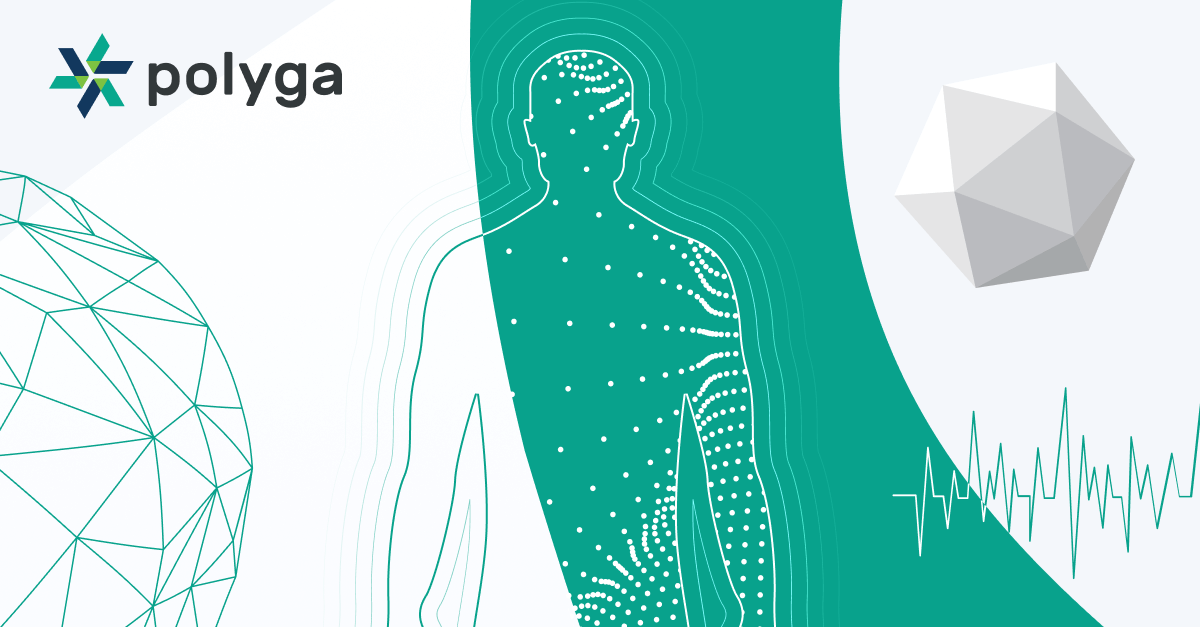
For example, 3D body and face scanning are reshaping cosmetic and plastic surgeries, enabling precise planning for improved aesthetic and functional outcomes. In operating rooms, 3D surgery planning has become the norm, providing surgeons with detailed previews of complex procedures to minimize risks and enhance recovery times. The insights gained from 3D medical scanners refine treatment accuracy and aid in diagnosing complex or rare conditions.
Let’s jump into the world of medical 3D scanning!
3D Scanning Medical Applications
3D scanning is changing healthcare by allowing super personalized and accurate medical treatments. This tech helps experts customize treatments for patients across different fields, improving outcomes in orthopedics, dentistry, cardiology, and beyond. So, let’s dive into how 3D scanning is shaking things up in these fields.
Orthopedics
In orthopedics, 3D scanning is transforming the creation of custom implants and prosthetics. Imagine a world where every implant is a perfect match for the patient’s body. With detailed 3D orthopedics scans, surgeons craft implants that enhance surgical outcomes and recovery times, ensuring perfect patient anatomy integration. Dr. Shahriar Seddigh from Dalhousie University showcased this, using the Polyga Compact S1 3D scanner in a study that measured bone defects in bovine tibial specimens with astounding precision.
Dentistry
At the Pacific Dental Conference 2023, the spotlight was on 3D scanner dentistry, showcasing how tools like the Polyga H3 3D Scanner are transforming the field. These scanners capture precise images of a patient’s mouth, enabling creating digital models that perfectly align with each individual’s unique dental anatomy for implants, crowns, and orthodontic devices. This technology not only ensures optimal fit and functionality but also speeds up the treatment process and makes procedures less invasive.
Plastic and Reconstructive Surgery
Precise pre-surgical planning and clear outcome visualizations are made possible by 3D scanning in plastic and reconstructive surgery. Surgeons use technologies such as the Polyga Compact L6 3D scanner to accurately capture facial expressions and surgical areas, which is crucial for complex procedures like facial reconstructions or detailed skin grafts.
For example, the L6 scanner’s high-resolution imaging supports surgeons in creating more natural-looking restorations. It allows patients to preview potential cosmetic changes pre-surgery, increasing their satisfaction with the outcomes.
Cardiology
3D scanning revolutionized cardiology, particularly in creating precise heart models that offer detailed insights into cardiac conditions. 3D hearts, for example, are crucial for training, allowing medical professionals to visualize complex organ structures and plan surgeries with unprecedented accuracy. They enhance surgical planning by identifying optimal strategies and potential complications in advance, improving outcomes in procedures like valve replacements and congenital defect repairs.
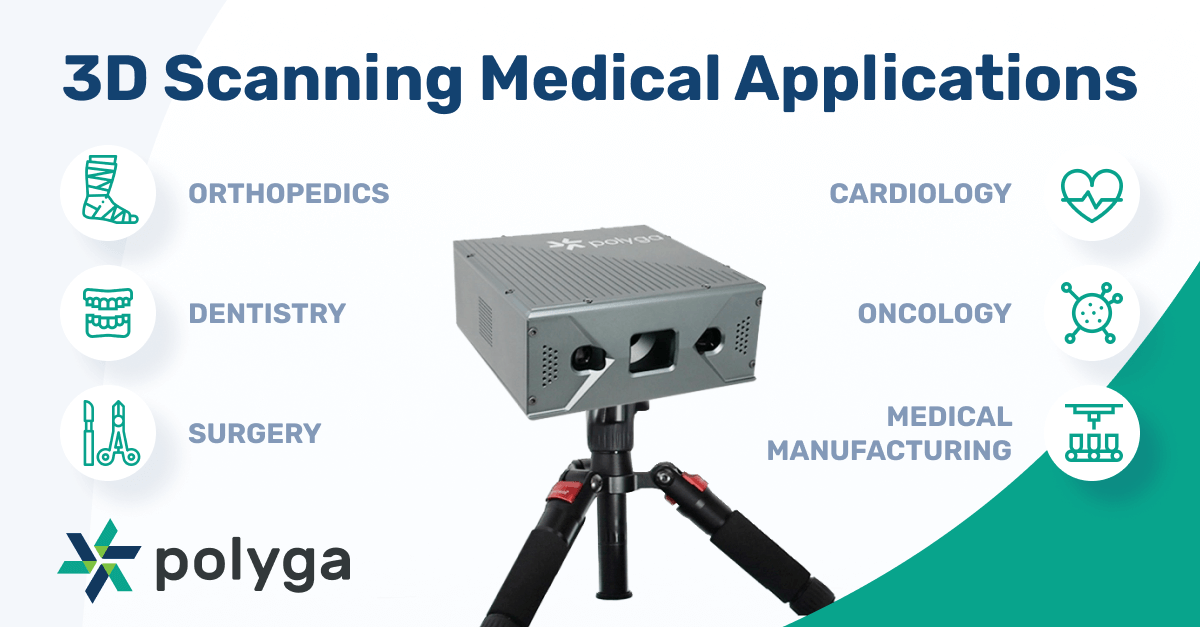
Oncology
3D scanning is reshaping oncology, offering detailed images that pinpoint tumor size, shape, and location — crucial for accurate staging and tailored treatment plans. These scans enable oncologists to devise personalized therapies that target tumors while conserving healthy tissue. In surgical settings, 3D models allow surgeons to pre-visualize and refine their strategies, ensuring comprehensive tumor removal and vital tissue preservation.
These models are also integral in radiation therapy, where they help focus treatments precisely, minimizing harm to healthy cells and enhancing patient recovery. This meticulous planning improves treatment efficacy, streamlining the cancer care process and enhancing patient outcomes. Such technologies have proven invaluable in complex pediatric oncology cases, as shown in studies involving challenging tumors where 3D imaging and printing significantly aid surgical precision and planning.
Custom Medical Devices Manufacturing
With the help of 3D scanning, creating custom medical devices has been revolutionized, offering a rapid and precise way to cater to individual needs. From orthotic supports to prosthetic limbs, this technology ensures devices fit perfectly and function optimally to meet specific medical and patient requirements with exceptional accuracy.
Matthew Percival at 3DRE exemplifies this with reverse engineering using the Polyga Compact S1 and Xtract3D software, demonstrating the efficiency of combining 3D scanning and manufacturing to optimize design and production.
Benefits of 3D Scanning in Healthcare
With 3D scanning, healthcare is experiencing a transformative shift, granting healthcare providers the ability to deliver personalized and precise patient care like never before. This technology customizes treatments for better results in surgery and patient recovery. Learn about the many advantages of 3D scanning in modern medicine, including custom medical device production and advanced preoperative planning.
Increased Precision and Personalization
3D medical scans in healthcare significantly enhance treatment customization to fit the unique anatomical details of each patient, from 3D dentistry to 3D heart models. It accurately captures body images to create tailored medical solutions. Customizing prosthetics, dental stuff, and surgical plans depends on this precision, so treatments fit each person’s needs perfectly. For instance, orthopedic implants designed from 3D scans integrate flawlessly with a patient’s existing bone structure, improving recovery speed and increasing comfort and satisfaction.
Enhanced Preoperative Planning & Rare Medical Condition Diagnosis
By utilizing 3D scanning, surgeons can meticulously plan and execute procedures during preoperative preparation, resulting in reduced complications and faster recovery. It offers clearer and more detailed images than traditional methods, enhancing the diagnosis and management of rare conditions. In pediatric care, 3D scanning enables precise evaluation of congenital anomalies, significantly improving both immediate and long-term outcomes.
Cost-Effectiveness
3D scanning not only enhances surgical precision but also offers significant cost savings by optimizing surgery durations and reducing resource waste. Shorter surgeries and less anesthesia usage lead to reduced hospital stays. 3D printing custom medical devices from direct scans reduce material waste, boosting economic and environmental efficiency.
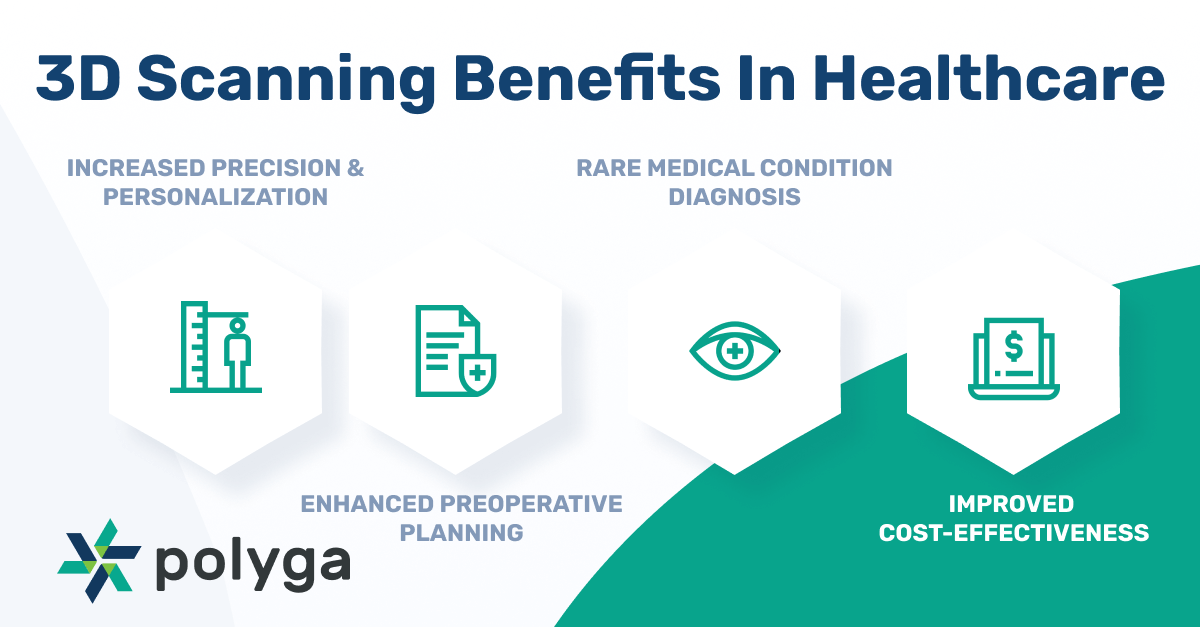
A Realistic Look at 3D Scanning’s Challenges
While there are numerous advantages to using 3D scanning in healthcare, it is important to acknowledge the challenges and limitations it poses. This section covers accuracy concerns, high costs, integration complexities, and regulatory issues. Knowing these challenges is essential for using 3D scanning ethically and effectively in medical practices.
Accuracy Concerns
3D scanning, while highly precise for many medical applications, can face issues like poor calibration, patient movement during scanning, or low resolution. These factors can introduce errors in the scans that potentially affect surgical outcomes or device fit, sometimes leading to procedural complications or adverse outcomes.
High Costs of Advanced Scanners
High-resolution 3D scanners require significant initial investments and ongoing maintenance, software updates, and training costs. These expenses can be restraining for smaller medical facilities or those in less affluent regions, potentially exacerbating disparities in medical service quality.
Integration with Existing Systems
Incorporating 3D scanning into existing healthcare IT infrastructures is challenging. Many health facilities use older systems that may not support the latest 3D scanning technologies, leading to integration and data management issues. This often requires extensive IT support and system overhauls, which can disrupt current operations and cause additional staff training.
Regulatory and Ethical Issues
3D scanning in medicine comes with crucial regulatory and ethical considerations. Protecting patient privacy and securely managing the sensitive data obtained from scans is crucial. Healthcare providers must ensure that they provide patients with full information about how their data will be used, especially when scans involve detailed and personal anatomical images. Properly navigating these issues is vital to maintaining ethical standards and trust in 3D scanning applications in healthcare.
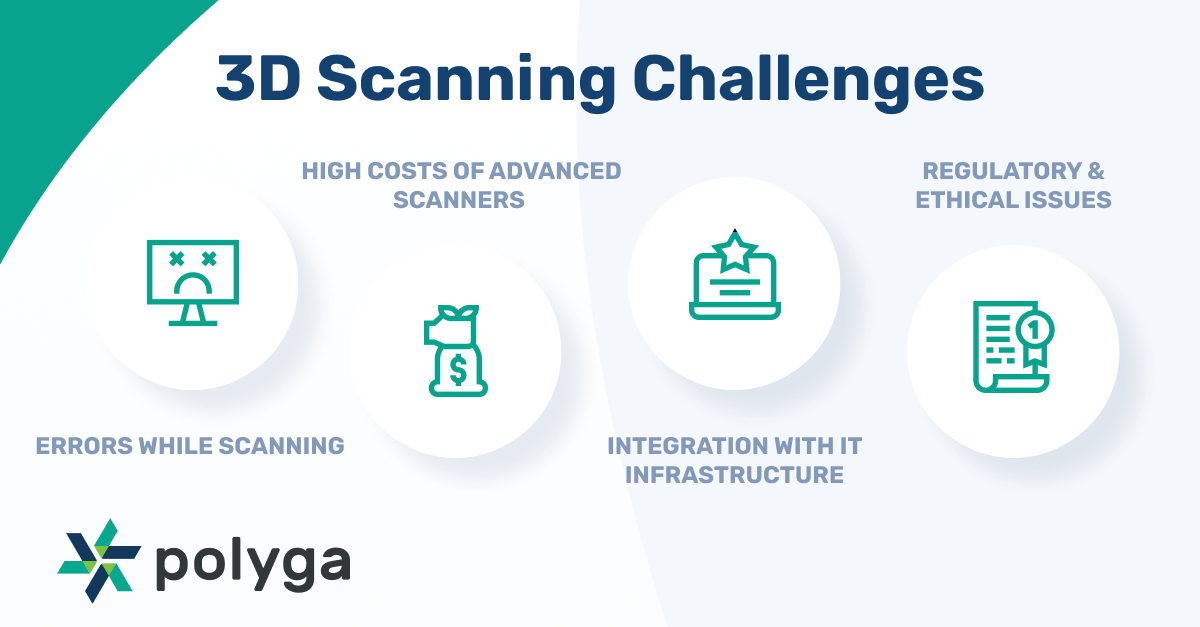
The Future of 3D Scanning in Healthcare
Healthcare is getting improved with 3D scanning tech. Integrating AI and machine learning in 3D scanning enhances precision and speed, paving the way for new applications in medical innovation. So, let’s look further.
Emerging Trends
A key trend in 3D scanning for healthcare is integrating AI and ML, which significantly enhances scanning accuracy and processing speed. AI algorithms swiftly analyze 3D data, uncovering details and anomalies that might go unnoticed, aiding in early and precise diagnostics. Machine learning continuously refines its ability to distinguish between normal and abnormal tissues, enhancing scan precision for tailored treatment plans.
AI automates complex tasks like image segmentation and 3D model reconstruction from 2D scans, speeding up medical workflows and reducing patient wait times for diagnoses and treatments. As these technologies advance, they will become integral to 3D scanning systems, broadening their use in healthcare.
Potential New Applications
As 3D scanning technology advances, its potential in medicine expands, particularly in telemedicine. By enabling precise 3D imaging, specialists can provide remote diagnostic and treatment support, improving access to care in underserved areas. This is crucial for specialties like dermatology and chronic wound management.
In bioprinting, 3D scanning drives the development of personalized tissue implants and organ parts from a patient’s own cells, which could transform regenerative medicine by reducing the risk of rejection. It’s innovating drug delivery systems with implantable devices that release drugs based on specific bodily conditions, tailor-made for each patient. These advances showcase 3D scanning’s growing impact on medical practice and its potential to introduce new healthcare innovations.
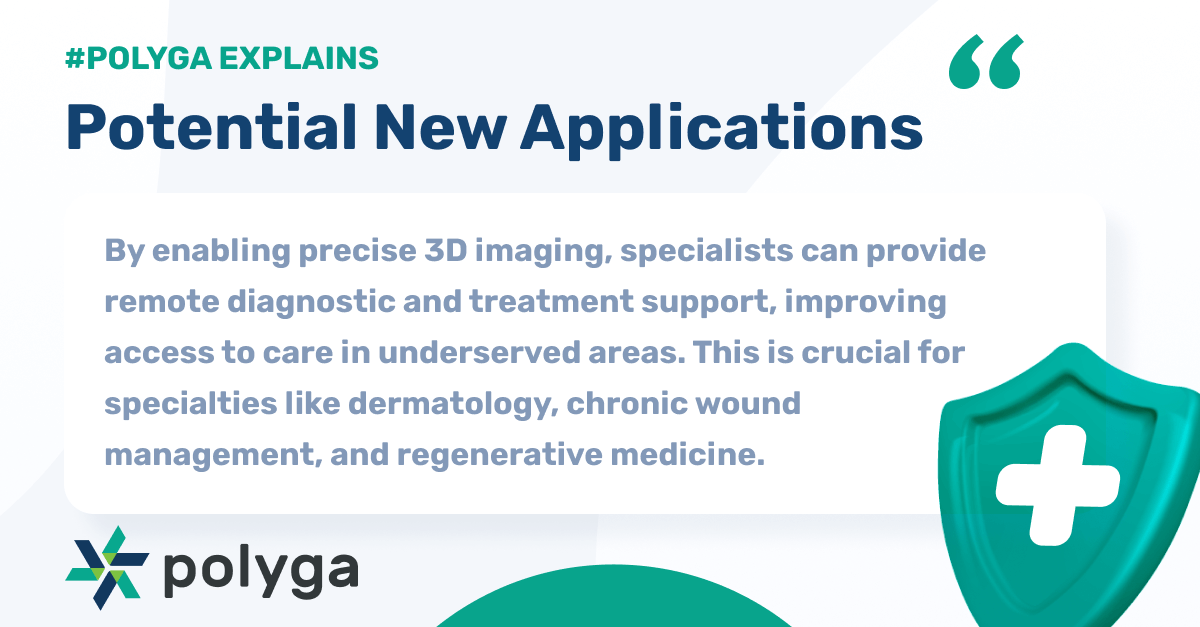
Polyga: 3D Scanning for Health & Wellness
Throughout this exploration, we’ve seen how 3D scanning is improving healthcare through enhanced precision, personalization, and efficiency in various medical fields. From creating bespoke prosthetics in orthopedics to aiding complex surgical planning and advancing the diagnosis of rare conditions, 3D scanning proves indispensable.
Check out our scan samples or consult with our experts to discover how our advanced 3D scanning solutions can meet your specific medical needs and elevate your practice. With Polyga, you’re not just using innovative technology; you’re setting new standards in healthcare excellence.
Contact us if you need help with your 3D scanning challenges.
FAQ
Q1: What does a 3D body scan tell you?
A lot more than you might think! From body composition to precise measurements for custom clothing and health monitoring, 3D body scans offer a detailed look at what’s happening under the skin.
Q2: What are the types of 3D measurement technologies?
From laser scanning to structured light and photogrammetry, each technology offers unique benefits, whether it’s capturing large objects or intricate details.

